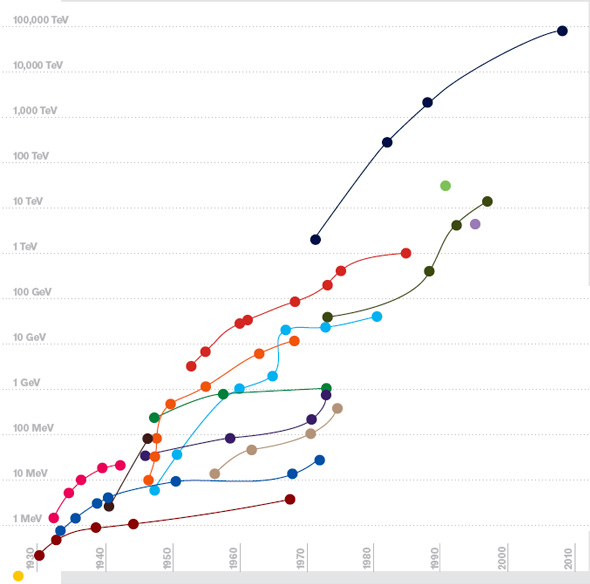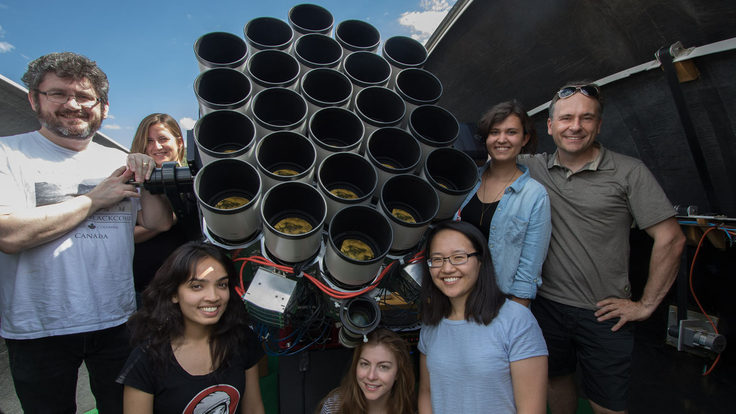First accelerator

Most accelerators in operation today, including thousands of machines used for treating the surfaces of materials, apply the same principle of resonance acceleration that Norwegian engineer Rolf Wideröe explored when he built the worlds first accelerator in Aachen, Germany in 1928. His linear accelerator, or linac, powered by an alternating voltage, propelled potassium ions through an 88-cm-long glass tube, achieving an energy gain equivalent to twice the peak voltage he used. This proof of principle opened the door to a vast new field of research and many types of accelerators.
|
Cyclotrons
 
More than 350 cyclotrons around the world produce radioactive isotopes for medical applications, such as PET scans. Inspired by Wideröes success, Ernest Lawrence and his student M. Stanley Livingston built the first of these circular accelerators, about four inches in diameter, and operated it in 1931 in Berkeley. (A) The cyclotrons magnetic field forces particles to travel in spirals. On each turn, the particles cross an electric field, which accelerates them to higher energy.
|
Cockcroft-Walton electrostatic accelerators

In 1932, John Cockcroft and Ernest Walton became the first scientists to split the atomic nucleus with artifically accelerated particles when they aimed a proton beam from a new type of accelerator at the nuclei of lithium atoms. Physicists still use Cockcroft-Walton accelerators to deliver strong, steady streams of low-energy protons. The machines can turn alternating currents into electrostatic fields corresponding to more than one million volts.
|
Van de Graaff electrostatic accelerators

Scientists used this type of accelerator for several decades in physics and biomedical research. Commercial companies now build modern versions of this machine. Invented at Princeton University in the 1930s, the accelerator generates a high voltage by charging a large sphere through a moving belt. In the early 1950s, the Massachusetts Institute of Technology donated its Van de Graaff machine to the Museum of Science in Boston, where visitors can still see it in action.
|
Betatrons

In 1940, Donald Kerst at the University of Illinois modified the design of the cyclotron to accelerate particles to higher energy. The betatrons large magnet provides a variable field and keeps particles on a circular orbit inside a beam pipe, a major step forward in accelerator technology. In 1957, Dr. O. Arthur Stiennon opened in Wisconsin the first private medical center to treat cancer patients with a betatron. Because of cost and size limitations, demand for betatrons started to fall in the 1970s.
|
Synchrocyclotrons

For many years physicists struggled to build accelerators that work for both low- and high-speed particles. The problem is that slow particles gain energy and speed when traveling through an electric field while particles traveling close to the speed of light gain energy while barely speeding up at all, a phenomenon explained by the theory of special relativity. This creates a timing problem in accelerators with electric fields that alternate at constant frequency. The synchrocyclotron, invented in the 1940s but no longer built today, solved the problem by introducing an electric field with variable frequency, paving the way for even better accelerators.
|
|
Linear accelerators
 
Physicists built the first modern linear accelerators after World War II, using microwave technology developed for radar. Today, thousands of hospitals use linacs for radiotherapy in cancer treatment. (B) Linacs use radio-frequency waves to create electric fields inside cylindrical cavities. Luis Alvarez built the first standing-wave linac to accelerate protons at the University of California, Berkeley, in 1946. William Hansen and his team at Stanford University constructed the first traveling-wave linac to accelerate electrons in 1947. High-energy accelerators often rely on a standing-wave linac to give heavy particles an initial boost before injecting them into the circular machines that accelerate them to high energy.
|
Electron synchrotrons

The operation of the first electron synchrotron in the United States, at General Electric in 1946, led to the discovery of synchrotron radiation, the light emitted by charged, high-energy particles traveling in a circle. Today, more than 50 synchrotrons, known as lightsources, (C) produce intense beams of light for research in material science, chemistry, molecular biology, and other fields. By injecting particles into a synchrotron at close to the speed of light, scientists can operate its alternating electric field at an almost constant frequency. An adjustable magnetic field guarantees that the particles stay on a fixed circular path, so beams can circulate for long periods of time.
|
Proton synchrotrons

Because protons are about 2000 times heavier than electrons, they must be accelerated to higher energies, and hence over longer distances, to attain relativistic speeds. The discovery in the 1950s of strong beam focusing, which controls the size of a particle beam through a series of magnets, allowed the construction of large, circular proton accelerators for nuclear and high-energy research, starting at Brookhaven National Laboratory and the European laboratory CERN. Hospitals have begun to use proton synchrotrons for cancer treatment.
|
Storage ring colliders
  
Particle colliders have led to the discoveries of many subatomic building blocks and the forces that govern their behavior. Storage ring colliders are based on synchrotron technology. They accelerate two beams of particles in opposite directions and circulate them for hours. Every time the beams cross, a few particles collide. In the 1960s, scientists built the first electron-positron collider at Frascati, Italy, followed by machines in the United States and Russia. Today, colliders at KEK, Fermilab, Brookhavenand, soon, CERN (D)smash electrons, positrons, protons, antiprotons, and ions into each other. Scientists now are developing the technology for a proposed muon collider.
|
Linear colliders

The Stanford Linear Accelerator Center started operating the worlds first linear particle collider in 1989. Today, a worldwide collaboration of scientists is advancing plans for the proposed International Linear Collider, which would use superconducting radio-frequency (RF) cavities to accelerate electrons and positrons to much higher energy than achieved at SLAC. A collaboration based at CERN is developing a new linac concept, the Compact Linear Collider.
|
|
Text: Kurt Riesselmann
Image: Adapted from the 2001 Snowmass Accelerator R&D Report
|
|








